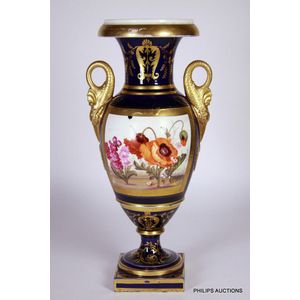Chamberlain's Worcester Vase and Pot with John Webster Decoration
You must be a subscriber, and be logged in to view price and dealer details.
Subscribe Now to view actual auction price for this item
When you subscribe, you have the option of setting the currency in which to display prices to $Au, $US, $NZ or Stg.
- Attributed - A cataloguing term where the item in the opinion of the cataloguers, is a of the period of the artist, craftsman or designer, and which probably in whole or part is the work of that person.
- Gilding - Gilding is a method of ornamentation whereby a thin sheet of gold metal is applied to items made of wood, leather, ceramics, glass and silver for decorative purposes.
For furniture including mirrors, the sheet of gold is usually applied over a coating of gesso. Gesso is a mixture of plaster of Paris and gypsum mixed with water and then applied to the carved wooden frames of mirrors and picture frames as a base for applying the gold leaf. After numerous coats of gesso have been applied, allowed to dry and then sanded a coat of "bole", a usually red coloured mixture of clay and glue is brushed on and allowed to dry, after which the gold leaf is applied. Over time parts of the gilding will rub off so the base colour can be seen. In water gilding, this was generally a blue colour, while in oil gilding, the under layer was often yellow. In Victorian times, gilders frequently used red as a pigment beneath the gold leaf.
Metal was often gilded by a process known as fire gilding. Gold mixed with mercury was applied and heated, causing the mercury to evaporate, the long-term effect of which was to kill or disable the craftsman or woman from mercury poisoning. The pursuit of beauty has claimed many victims, not the least of which were the artists who made those pieces so highly sought after today. - Campana Form Vases or Urns - A campana form vase or urn is a type of ceramic or metal container that is characterized by its reverse bell-like shape. The shape is typically wider at the top and narrower at the bottom, with a curved or flared opening at the top. The vase or urn may have a handle or handles on either side of the opening.The campana form was popular in ancient Greece and Rome, and the design has been revived in various forms throughout the history of art, including the Renaissance and the Art Nouveau period.
This item has been included into following indexes:
- Chamberlain Worcester (England) - ceramics 114
-
Worcester (England), item types
- pots and bowls 128
- vases 92
Visually similar items

A Grainger Lee & Co Worcester pedestal vase, circa 1815-20, the elegant Empire style vase with finely moulded dolphin handles and anthemion mounts, with a framed painted plaque of oriental poppies and stocks, upon a cobalt ground richly gilded with borders

A Royal Worcester vase, of baluster form with moulded mask handles, the flared neck with pierced decoration, painted with flowers with, a puce mark shape 1047. 40 cm high

A pair of Royal Worcester blush ivory and floral decorated vases. 40 cm high.

A pair of good quality Chinese cloisonne vases of baluster shape, with tall conical necks, profusely decorated with flowers, butterflies, etc., in various colours on a pale green ground. Height on wood stand (not matching) 23.5 cm
